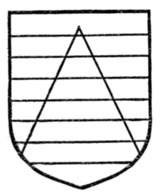A field divided horizontally into three equal divisions of e.g. gules, sable, and argent is theoretically blazoned by British rules "party per fess gules and argent, a fess sable." This, however, gives an exaggerated width to the fess which it does not really possess with us, and the German rules, which would blazon it "tierced per fess gules, sable, and argent," would seem preferable.
A field which is barry may also be counterchanged, as in the arms of Ballingall, where it is counterchanged per pale; but it can also be counterchanged per chevron (Fig. 123), or per bend dexter or sinister. Such counterchanging should be carefully distinguished from fields which are "barry-bendy" (Fig. 124), or "paly-bendy" (Fig. 125). In these latter cases the field is divided first by lines horizontal (for barry) or perpendicular (for paly), and subsequently by lines bendy (dexter or sinister).






